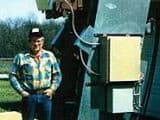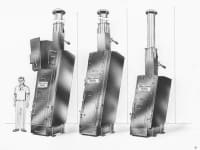A new technology that can combust, gasify or pyrolyze solids, liquids and sludges and divide the process into multiple stages and manage each stage of conversion for optimum results and “engineer” the fuel liquids and gases produced in continuously recharged conversion chambers where selected conversion processes can be automatically computer optimized for each of the feedstocks being individually processed and that can be made and marketed worldwide.
1. GENERAL DESCRIPTION
The Sequential Grates (tm) conversion system consists of a tall, free standing and self-contained, firebrick or ceramic lined dryer, combustor, furnace, gasifier, pyrolysis unit or boiler. Contained within the unit is a fully automatic solid fuels stoking system consisting of several pivoting grates and a manually or computer controlled operating system. Air pollution abatement (via secondary combustion) can be combined within the design. Fully automatic fuel input, heat or power output and ash removal are readily available design features.
2. TECHNOLOGY EMPLOYED
Combustion, gasification and pyrolysis of biomass and waste resources are now proven technologies, employed in both small and large scale applications. The ability to more efficiently and simultaneously co-fire difficult and incompatible blends or combinations of wastes, biomass and conventional fossil fuels is combined in the new concept conversion furnace. Solid fuels are introduced into the unit through an opening, from a conveyor, and are then dropped downward “sequentially”, from grate to grate. The grate design and action is such that these solid fuels are classified by size, and dropped to reposition them periodically and to separate accumulated ashes automatically while conversion commences.
The Sequential Grates (tm) stoking action starts at the bottom grate and moves (from grate to grate) -sequentially- upwards, so as not to drop fuels onto grates already containing fuel. Pollution abatement can be incorporated, within the system by the addition of a proprietary smoke re-circulation system and/or by the addition of gas burners to re-ignite and achieve secondary combustion of the remaining volatile organic gases and particulates. Other off-the-shelf abatement technologies may also be employed.
3. ADVANTAGES
Advantages of the Sequential Grate system are the ability to utilize the various renewable biomass and waste fuels available in a given area at any time and allows co-firing these with conventional fuels when desirable. Co firing has economic and environmental advantages as it provides plant operators the ability to select the most economical and environmentally friendly fuel combinations at any time or place. In the AAEC Sequential Grates (tm) combustion system this flexibility is further combined with a multi-stage combustion process, to maximize benefits the fuels flexibility provides. It further combines this over all fuel flexibility with an inherent, effective and economical air emissions control system. These advantages are useful in both area and district heating, co-generation, distributed generation, independent power production and could be used effectively for base load power generation.
Like this entry?
-
About the Entrant
- Name:Leslie Blevins
- Type of entry:individual
- Patent status:patented





